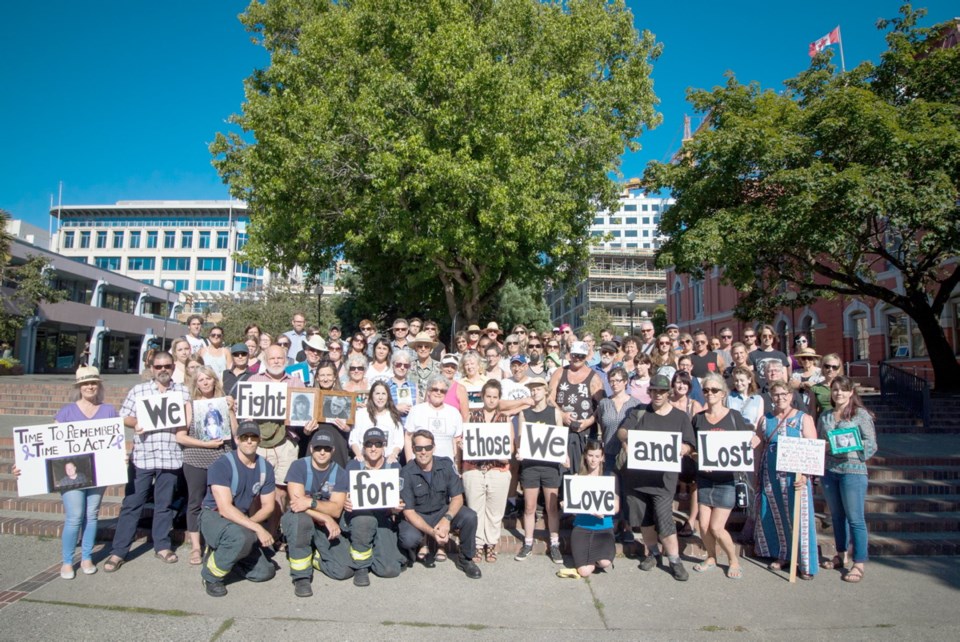For the past several months, a group of frontline workers, illicit-drug users and parents have met to discuss how they can better inform the public on the one thing that unites them: The overdose crisis.
“It’s such a diverse mix of people, but we’ve all been affected,” said Leslie McBain, a founding member of Moms Stop the Harm.
She lost her only son, Jordan Miller, to an opioid overdose in 2014. She has helped support other parents and has become a respected advocate at all levels of government.
Almost 2,000 people have died from illicit-drug deaths in B.C. since 2016, with more than 283 of those deaths on Vancouver Island. Despite an emergency health crisis being called, a prolific dispersal of the opioid antidote naloxone and dozens of overdose-prevention sites being opened, the crisis is getting worse, according to monthly statistics from the coroners service.
McBain was invited to be part of the organizing committee for International Overdose Awareness Day in Victoria after being a guest speaker last year. The event takes place in Centennial Square this Thursday, with community naloxone training, speakers and a vigil. Similar events are taking place in Nanaimo, Courtenay and Campbell River.
“With so much going on, AIDS Vancouver Island invited some of us doing work at the community level to help. It really is grassroots groups coming together,” said McBain, who lives on Pender Island. The group also includes members of the Society of Illicit Drug Users and No More Drug War Victoria.
“It has been such a beautiful experience to work with this group, especially the parents who are honouring their kids,” said Heather Hobbs, harm-reduction services manager at AVI. The organization has had a huge response to community outreach, including a symposium in May, naloxone training and information booths at festivals.
Hobbs said everyone in the group identifies stigma — the negative judgment of people who use drugs or have addictions — as one of the most harmful factors in the crisis.
“That judgment, shame and lack of feeling welcome prevents people from seeking and accessing support. They become isolated. In a very tangible way, this is a killer,” said Hobbs, noting another element is the toxic drug supply. Fentanyl is a powerful, cheap opioid now found in the majority of illicit street drugs. Hobbs, and many other frontline advocates, think decriminalizing and regulating the drugs would curb demand for a toxic illicit supply and the number of overdose deaths.
“There are too many people dying to not talk about this seriously,” said Khalelay Bell from No More Drug War Victoria — a new group composed of outreach workers, advocates and illicit-drug users who were part of Yes2SCS, which spent years advocating for supervised-consumption services. Victoria just had its first site approved next to Our Place Society on Pandora Avenue and has four overdose-prevention sites. There are eight in total on the Island.
“The war on drugs criminalizes and stigmatizes people instead of helping and understanding them. Why are we moralizing a health issue?” said Bell, citing Portugal as having success with a decriminalization model. “This is not a difficult conversation. Asking a frontline worker how many funerals of friends they’ve attended recently is.”
Dana Tough is the Aboriginal harm-reduction counsellor at AVI and also a recovering drug user. He said it’s important for the whole community to come together in outreach.
“I really try to meet people where they are at. Even if it means hiking into the bush to deliver harm-reduction supplies,” said Tough, noting outreach is especially important for Indigenous people — who are five times more likely to overdose and three times more likely to die from an overdose than the non-Indigenous population, according to a recent report from the First Nations Health Authority.
“This is a societal issue. We are a drug-seeking culture, period. It could be anyone in your life or your family who has an addiction. We need a societal response,” he said.
Victoria Mayor Lisa Helps said she will spend Overdose Awareness Day at an addictions-recovery facility in Nanaimo with other capital region mayors.
“I can’t think of a better way to spend the day than looking at ways to support recovery options,” Helps said.
Our Place Society has pitched a recovery centre for the former youth jail in View Royal where it has operated a temporary shelter since 2016.
“I would really like to see funding of true recovery options that help people deal with the pain of addiction, both physical and emotional,” Helps said.
The City of Victoria declared Aug. 31 Overdose Awareness Day, and other council members are expected to attend, she said.
Overdose Awareness Day
International Overdose Awareness Day is set for Thursday. Events include:
Victoria: Starts at 4:30 p.m. in Centennial Square with free naloxone training and kits. At 6 p.m. there will be speakers, food and a vigil.
Nanaimo: From 2 to 4 p.m. at Maffeo Sutton Park (100 Comox Rd.). There will be testimonials and speakers.
Courtenay: Memorial at 6 p.m. at Simms Park (by the Fifth Street bridge across from Lewis Park).
Campbell River: Overdose prevention naloxone training today at 5 p.m. at the Campbell River Library (1240 Shoppers Rd.) and 10:30 a.m. at AVI (1371C Cedar St.).



